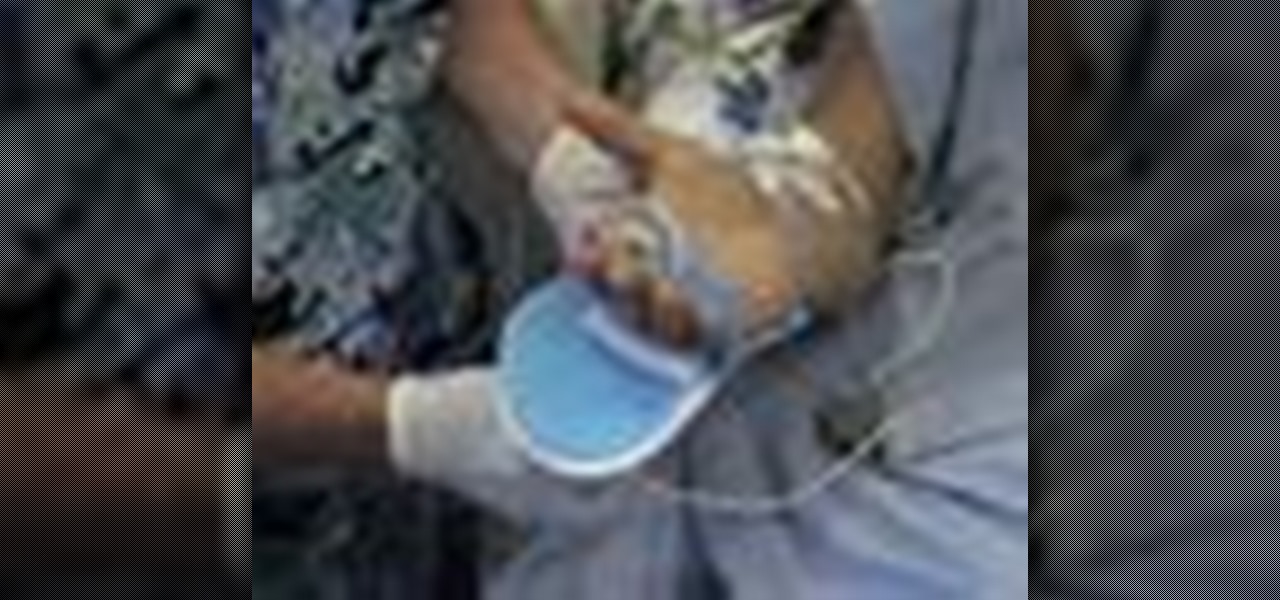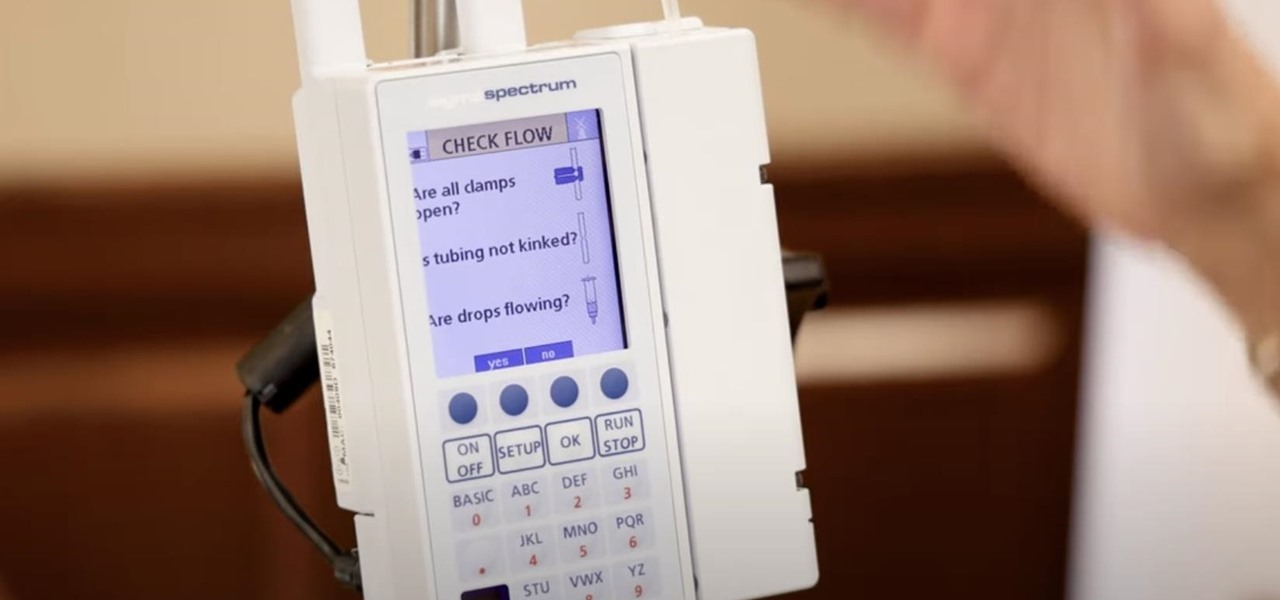Hot Medical Diagnosis & Procedures Posts


How To: Do a urinary catheterization procedure on a female
In many situations, learning proper medical procedures is difficult due to the urgency involved in patient care, so this video aims to prepare nurses so they can learn and stay fluent with the proper urinary catheterization of a female patient.
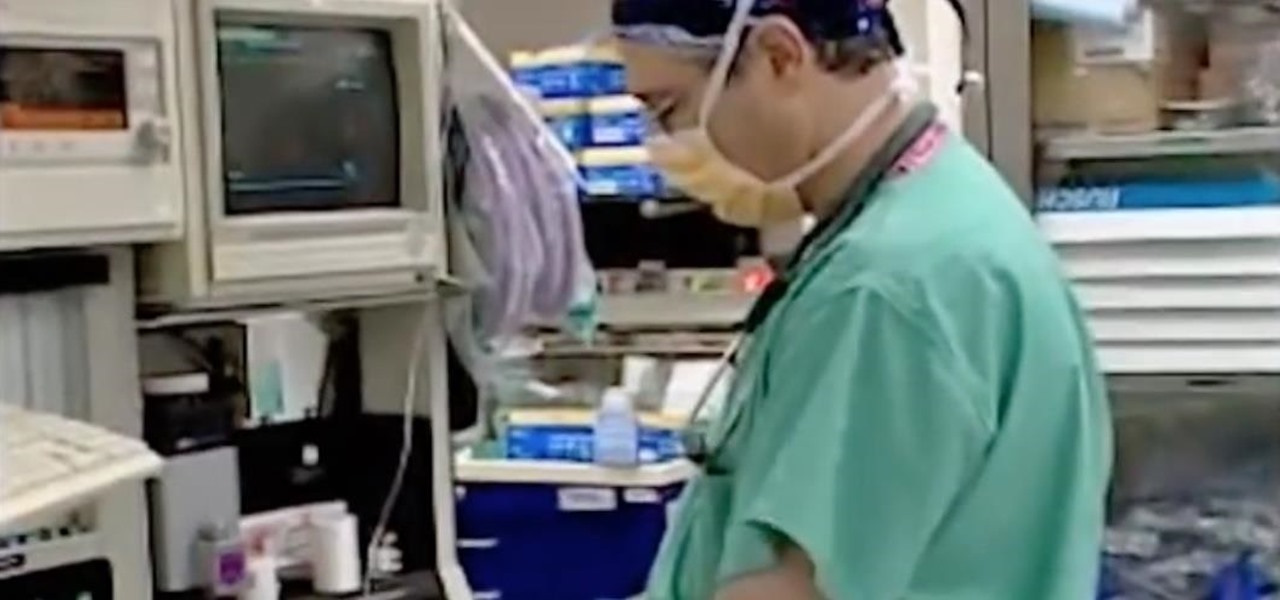
How To: Become an Anesthesiologist Easily
Becoming an anesthesiologist can be a tough and difficult task. They are required to take care of patients and provide pain relief when needed. During surgery, these people are given the responsibility to monitor certain functions to ensure the safety of the patient. So in this tutorial, find out what it takes to become an anesthesiologist easily. Enjoy!

How To: Treat ringworm
Have you ever gotten ringworm? It's pretty disgusting. It's caused by an overgrowth of a fungus. Learn how to treat ringworm from this professional dermatologist. The best treatment you should start with is an over-the-counter anti-fungal. If you don't see any improvement with daily use after two weeks, it's probably time to go call your dermatologist.

HowTo: Diagnose Anemia With a Salad Spinner
Another example of outstanding resourcefulness and ingenuity in the medical community (see earlier this week: Blood Sucking Plunger Could Heal Millions).

How To: Know When You're in Labor
Dr. Keith Eddleman explains in this video tutorial on how a woman can really tell when she is going into labor. Sometimes, it's hard for a first-time mom to naturally know when she's going into the process.

How To: Get pink eye from your makeup
Carolyn Dickerson teaches viewers about the connection between pink eye and makeup! Your pink eye may first start off and seem like a cold in your eye! Sometimes you may not know which pink eye you have. If the week progresses and your pink eye does not get any better, then you do not have a viral pink eye! It will continue to get worse if your eye does not drain properly! First, you can use sulfur based drops but this may be too much. You can also use a oral antibiotic! Swelling, draining an...

News: MIT Student Invents $3 Blood Sucking Plunger That Could Speed Up Healing for Millions
The medical field has known for some time now that negative pressure (re: suction) can drastically speed up wound recovery time. However, the machines that are currently available are quite expensive, and not an option for third world countries. Enter MIT student Danielle Zurovcik. The doctoral student has created a hand-powered suction-healing system that could completely revolutionize first aid in developing nations. Her device goes for only 3 bucks a pop.

How To: Take an arterial blood gas sample
This medical how to video demonstrates how to take an arterial blood gas sample. The purpose or arterial gas sampling is to assess the patient's respiratory status as well as the acid/base balance in their blood. To perform this medical procedure you will need the following instruments: protective eye wear, gloves, alcohol, iodine, arterial blood gas sampling kit, gauze and a bag of ice. Please not that this video is intended for medical professionals only.

How To: Perform a general eye exam on a patient
If you're a medical student, you'll learn a lot from this video lesson on examining your patient's eyes. If the patient is having trouble seeing, like double vision, blurred vision, pain or any other problem, a proper eye examination is detrimental to properly diagnosing and treating him/her. You can also determine and potential problems which may arise bases on your family history. Watch to see the complete procedure outlined, which is great for any med student or doctor. Even nurses can ben...

How To: Perform a general neurological exam on a patient
As a doctor, sometimes it will be necessary to perform a neurological examination of your patient to rule out any neurological disorders. Your objective is to identify abnormalities in the nervous system, to differentiate peripheral from central nervous system lesions, and to establish internal consistency. This is a great video less that outlines the complete neurological exam procedure. It's great for medical students or doctors, and even nursing students can learn a thing or two.

How To: Perform a general abdominal exam on a patient
Any patient with pain in the abdominal area will require you to perform an abdominal examination, and this video lesson outlines in great detail, how to perform a general abdomen exam. This is great for any medical student or up-and-coming doctor — even nursing students could benefit from this exam procedure. You'll learn about inspection of the abs, auscultation, percussion, palpation, the liver, the aorta, and the spleen. After watching the full procedure, you should be able to identify the...

How To: Perform a HEENT exam (head, ears, eyes, nose & throat)
Most won't know what the acronym HEENT stand for, but if you're a medical student, doctor or nurse, you know that it stand for head, ears, eyes, nose and throat. To perform a HEENT examination properly, you must know all the steps and techniques to diagnose your patient. This video lesson will outline the examination procedure, from start to finish, and shows you general palpation techniques and examining the temporomandibular joint, superficial lymph nodes, thyroid gland, eyes, ears, nose, m...

How To: Perform a cardiovascular exam on a patient
The key to being a good doctor is great patient care and thoroughness, and those are exactly the skills you will learn in this video lesson, as you learn to perform a cardiovascular examination on your patient. This is a great, step-by-step resource for the proper examination procedure. Every medical student should know these techniques, and nursing students could benefit from this knowledge, too. Every cardiovascular exam should include inspection of the pulse, blood pressure, carotid pulsat...

How To: Perform a general chest exam on a patient
There's no better way to learn then by visual media, and that's what makes this video lesson on performing a chest exam so great. It's perfect for any future doctor, and great for nursing students to understand the proper procedure for examining a patient's chest. Medical students can easily learn how to perform a general chest exam, because ever step and technique is outlined and shown. A chest examination is very important to determining what's wrong with your patient, and you will be able ...
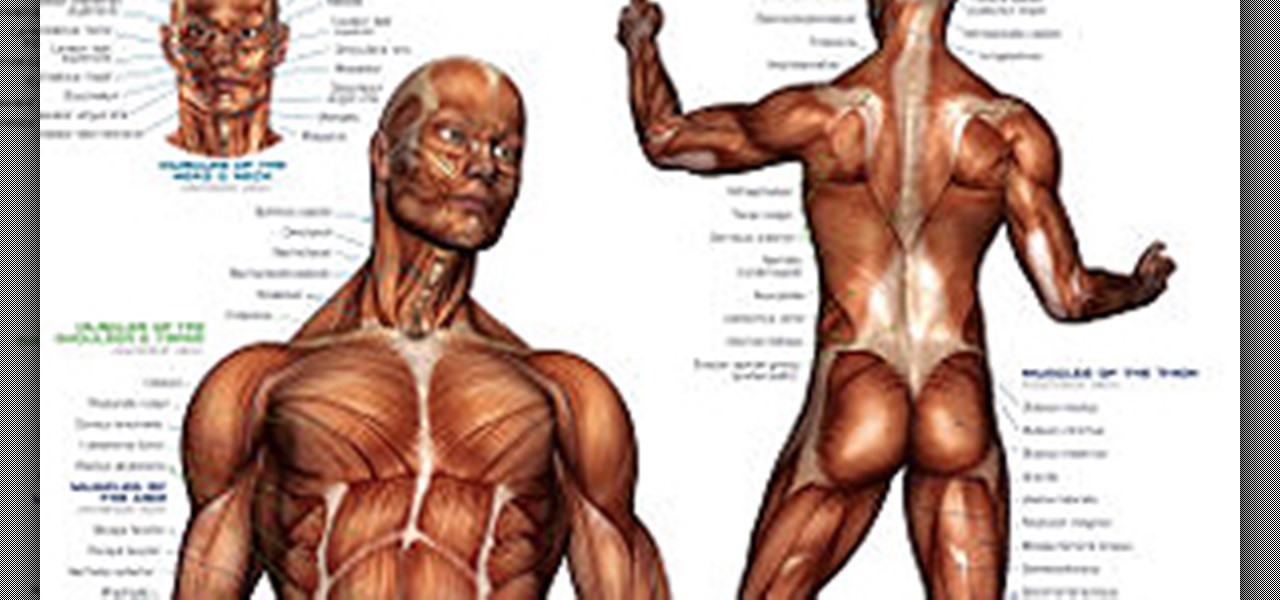
How To: Perform a musculoskeletal exam on a patient
Whether your training to be a doctor or a nurse, there is no doubt that this video lesson will help you better understand the procedure for musculoskeletal examinations. Musculoskeletal exams rely exclusively on inspection and palpation and tests using a combination of those techniques. The main purpose of this exam is to identify in your patient any signs of musculoskeletal disease, by way of pain, redness, swelling, warmth, deformity, and loss of function. Watch this video to see the entire...
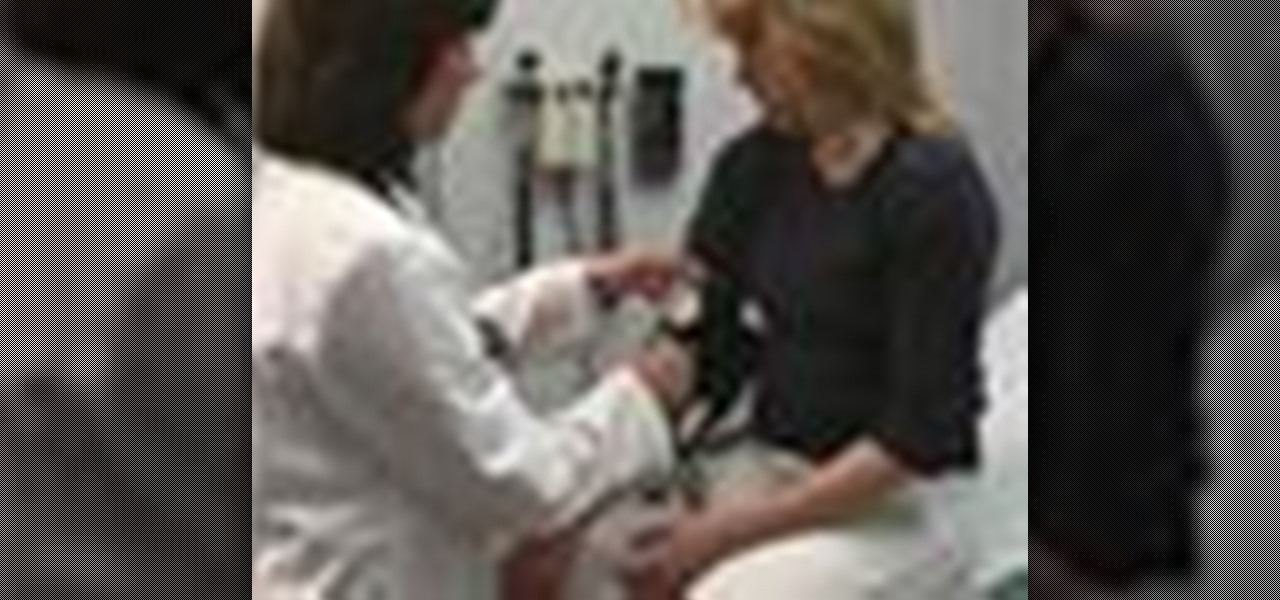
How To: Examine a patient for vital signs
Any medical student could benefit from this video lesson, whether you're training to be a doctor or a nurse. The very first step to finding out what's wrong with your patient is examining him/her for their vital signs. You must check the patient's pulse, respirations, blood pressure, and know how to use every kind of sphygmomanometer. To see the entire examination procedure, perfect for nursing students, watch the video to see how to examine a patient for vital signs, and refer to the steps b...

How To: Control your hyper tension
Is work, the recession, life in general stressing you out? Maybe all these stresses are causing hyper tension. This video shows you what you have to do to control your hyper tension. Some alternatives, as well as symptoms so you can better understand and in turn control your hyper tension and reduce stress.

How To: Check yourself for testicular cancer
21st Century Boy demonstrates how to check yourself for testicular cancer. After a warm bath or shower, lift up your leg and rest it on the edge of the bathtub. Lift up your right testicle with your left hand and take the thumb, forefinger and index finger of your right hand and check the testicle. Switch hands and repeat the process for the other testicle. There should be a soft lump at the front and the back of the testicle. There should also be a smooth, firm tube running up the side. If y...

How To: Check for a fever accurately
Feeling someone's forehead when they are sick is an outdated way to check for a fever. Follow along with this video and learn how to take an accurate reading so you know whether or not to seek medical help.

How To: Impress your doctor by knowing key phrases
Want to impress your doctor? Check out this video and learn a few fancy names for common problems and soon your doc will be in awe of your smarts.

How To: Tape your ankle to prevent an inversion ankle sprain
First locate the distal fibula and stabilize the distal leg with your non mobilizing hand. If the position of the fibula with anterior and posterior glide provides no pain then you will need to apply a five centimeter piece of tape 2. 5 centimeters anterior to the distal fibula with the distal fibula exposed under the tape's edge. Relocate the distal fibula and hold another piece of tape near the distal fibula, then you will need to wrap the tape circularly around the leg. You will also need ...

How To: Wrap your ankle after an injury
As you apply the wrap you want the most pressure down by your toes and the least up your leg above your ankle. That keeps swelling out of your feet and back up toward the heart. Start by wrapping around the base of the foot. As you move up toward the ankle you will begin wrapping the ankle in a figure eight going around the ankle and then around the foot. You want to wrap the ankle 3-4 times to give it some good stability. Then wrap the ankle in circles around the ankle and then up the leg. Y...

How To: Tape a sprained ankle
This is for an ankle that has been rolled to the outside of the body. Start by cutting a piece of rock tape that is about the length of the distance from the mid arch to right below the kneecap. To tape the ankle sit on a table put your heel on the edge of the table with your toes pointed down. With an ankle sprain this will be very painful so go really slow. Pull an inch of backing off the tape and anchor it about mid arch and then pull the backing off of the rest of the tape. Then with your...

How To: Properly tape an ankle
In this how-to video, you will learn how to properly tape an ankle. This is important if you have trouble with your ankle turning. First, spray some pre-tape on the foot. Put on some Pro Wrap so that the tape does not tear the hair on your legs. Put some heel and lace pads on so that the friction of putting on a shoe does not cause blistering. Put in about two to three anchors. Do not use zinc oxide tape around the muscle, so place it under the muscle. Now, start the tape on the inside of the...
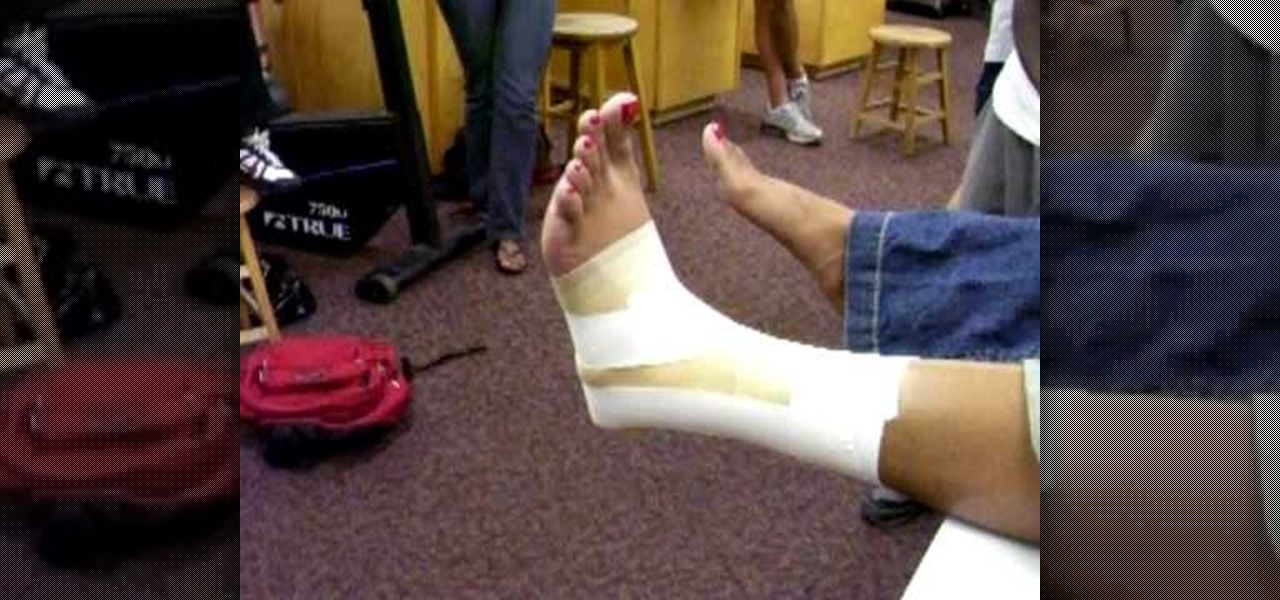
How To: Perform a simple ankle tape job
Sports medicine skills can be tricky and confusing. This video shows you how to tape an ankle correctly to immobilize the joint and keep it protected. You'll learn rules about where to tape and where not to tape. Tension is important and this instructor covers where to add tension and where not to. Using a few simple techniques, you'll learn how to wrap safely from below the calf and down the foot. Learn a few taping techniques like the figure eight, anchoring, stirrups and basket weaving to ...
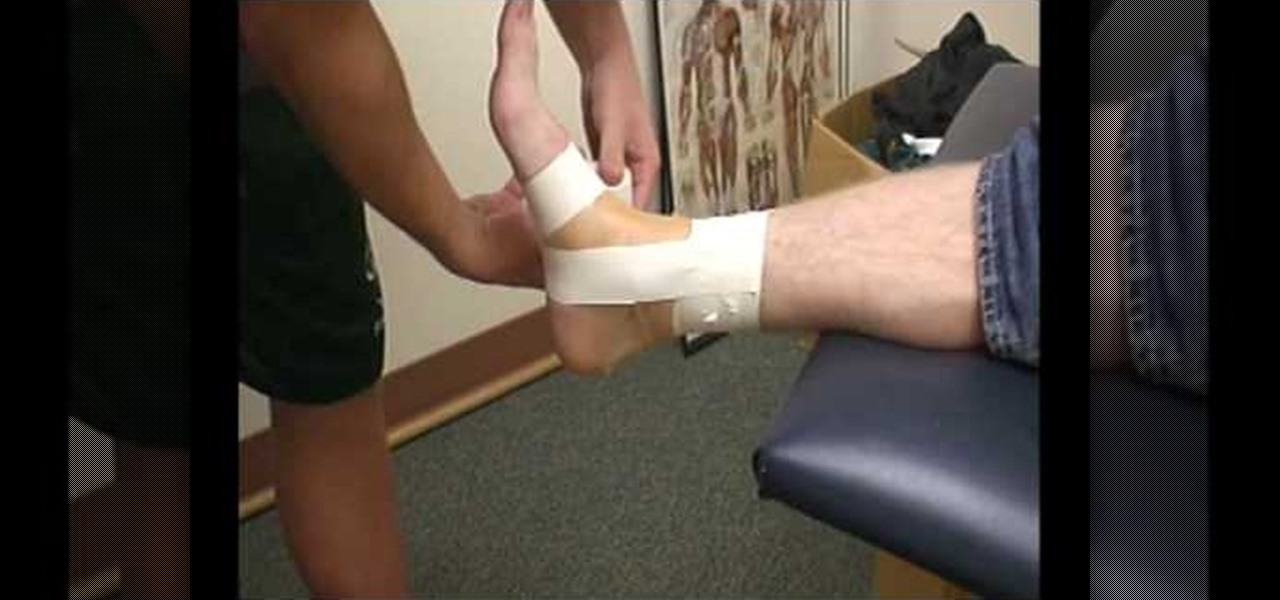
How To: Easily tape an ankle to prevent an injury
In this Diet & Health video tutorial you will learn how to easily tape an ankle to prevent an injury. Place the injured foot on a soft furniture with the ankle protruding out. Toes should be pointing upward. Place two pads one on top and the other below the ankle. Start wrapping the tape around the leg starting about 3 inches from above the ankle. Cover up to the ankle and then go below the foot and take three turns, then cover the heel and come over the ankle. Now put three anchors on the to...
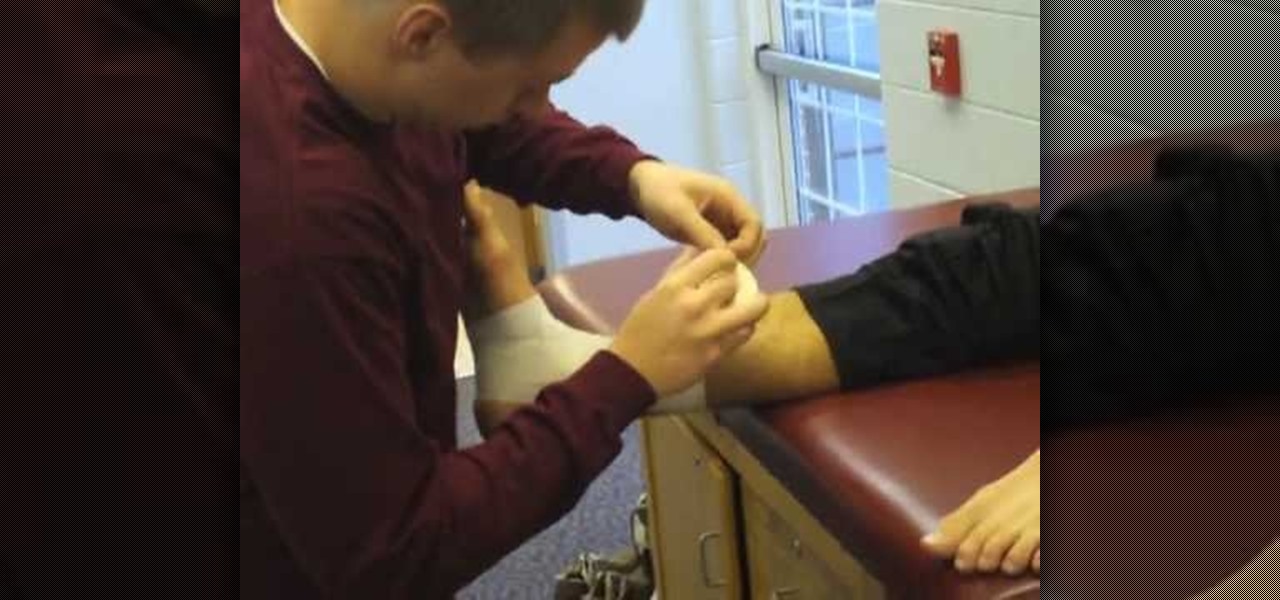
How To: Tape an ankle with a basketweave job
This wrap is intended to support and stabilize the ankle joint. Supplies needed include a 1 - ½'' – 2'' adhesive tape, pre-wrap, and heel and lace pads. Apply heel and lace pads at high friction areas, including the distal aspect of the Achilles tendon, and the dorsal aspect of the ankle joint. Apply under-wrap to secure them in place. It is critical that the foot remains at a ninety degree angle for this portion of the procedure. Apply an adhesive tape anchor strip at the lower leg, approxim...
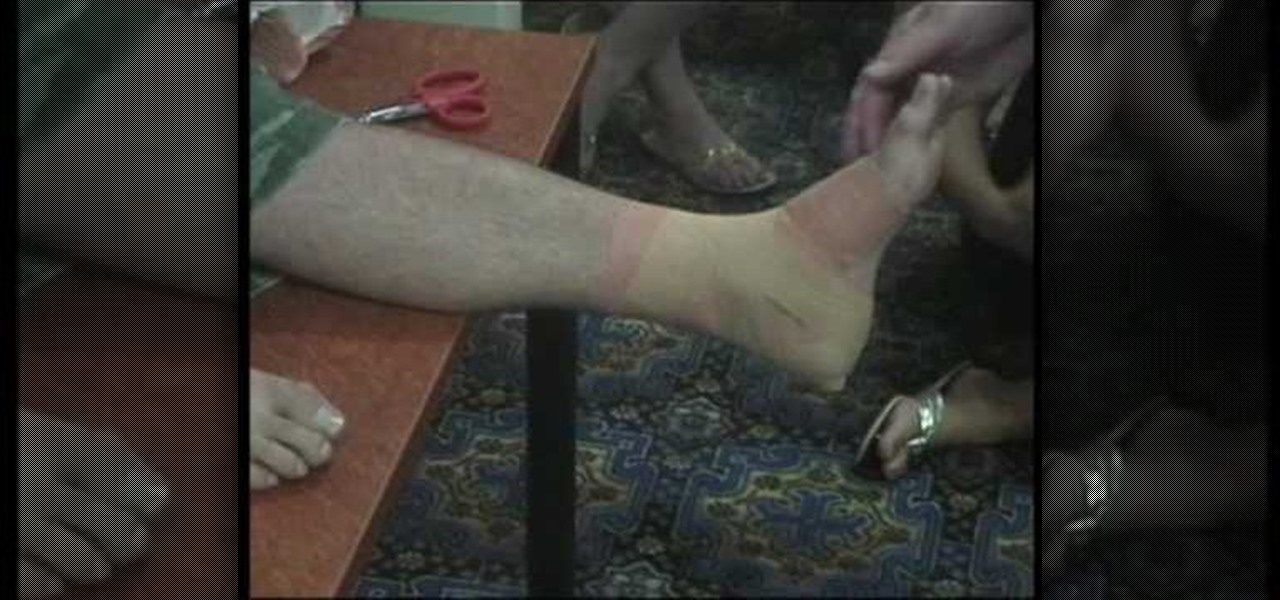
How To: Perform a basket weave ankle taping
Dave Watkins from the Wakefield Sports Clinic demonstrates how to perform a specific type of ankle taping. This basket weave taping is very common for people who have previous ankle injuries. This taping technique provides great support for all athletes. The taping is done by taking two strips, one little and one larger. Pull the tape from the outside of the ankle all the way across to the inside of the foot going underneath the foot. Next take straight strips and tape them from the base of t...

How To: Prevent gastroesophageal reflux disease (GERD)
In this video tutorial by Dr Suzann Wang you will learn how to prevent gastroesophageal reflux disease (GERD). It is a hyper or low acidity problem in the stomach. The ph factor measures the acidic or alkaline nature of anything and it has a range of 0 to 14; 14 being highly alkaline and 0 being highly acidic. The stomach acidity tends to be 2. 0 which is pretty acidic. The acidity should be 2. 40. If the acidity is lower, it affects the rest of the digestive system. You can rectify this by t...
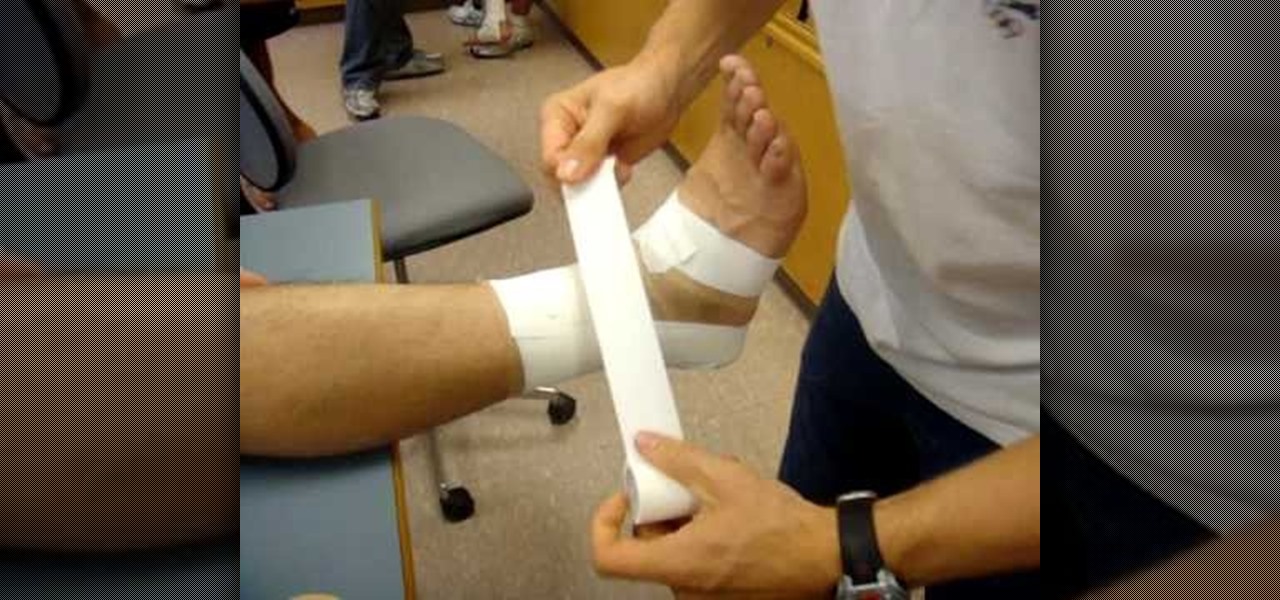
How To: Perform an ankle tape job
This Diet and Health video tutorial will demonstrate to you how to do an ankle tape job. Take two pads and put them on top and back of the ankle with the toe facing up. Then take the tape and pull it tight. Start about two to three fingers below the calf. Wrap the tape nice and tight around the leg going round and round all the way down to the ankle. Then dive down under the foot and come around under the back of the heel and cut it off. Now you put the first anchor right around the foot. The...
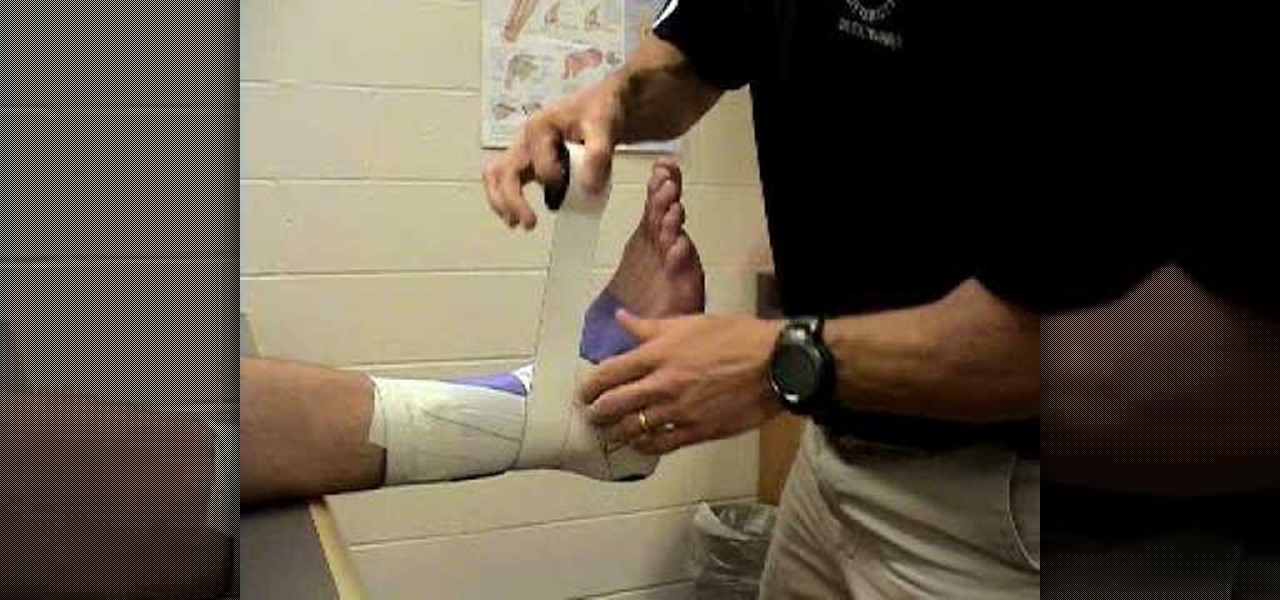
How To: Tape an ankle to help prevent injuries
This Diet & Health video tutorial shows how to tape an ankle to help prevent injuries. Place the foot on soft furniture with the ankle protruding out. Toes should be pointing upward. Start wrapping the tape around the foot starting about 3 inches from the toe. Cover up the ankle properly and then go on to the leg and take turns. This will cover up the entire area completely. Now put two anchors on the leg. Then, put three stirrups; pull up a little harder. On each stirrup put an anchor. Then ...
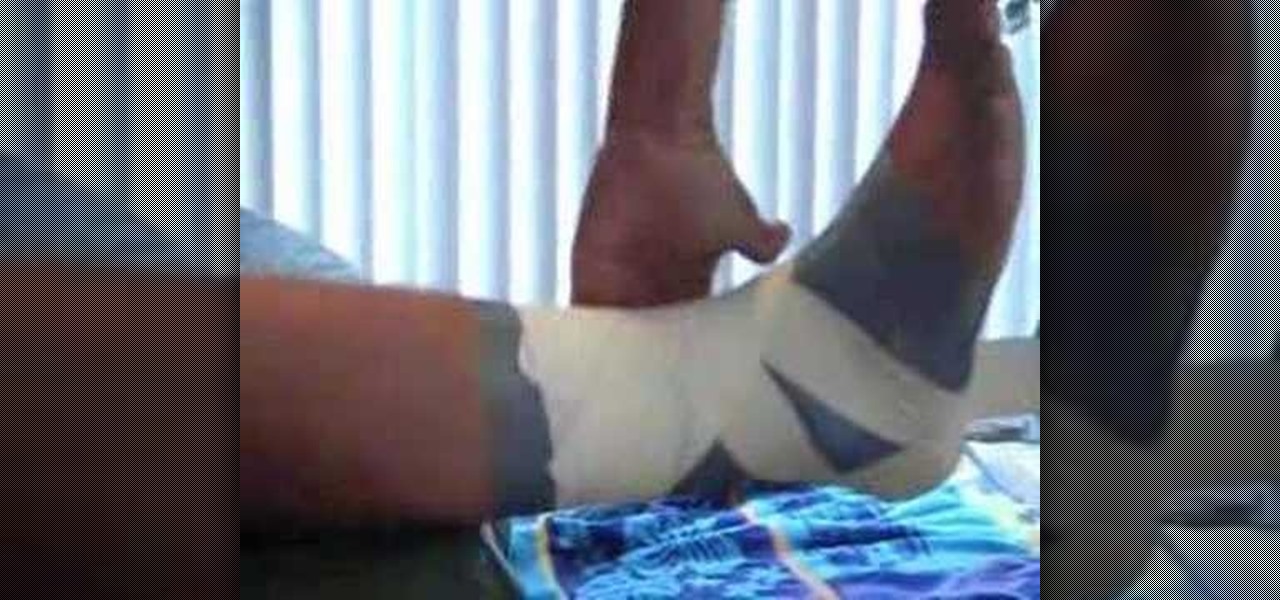
How To: Tape an ankle to prevent an inversion ankle sprain
Use tough skin spray adhesive, under wrap or pre-wrap, athletic tape to wrap an ankle. Position ankle in 90 degrees of dorsal flexion. Spray the adhesive to insure tight taping. Heel and lace pads are placed over tendons. Pre-wrap is applied, the goal here is to apply anchors so adhesive from tough skin will adhere to tape. Three layers are applied working towards the calf. Apply heel lock tape from the calf towards the heel, applying tension as you cross the bend in the ankle. The correct lo...

How To: Tape an ankle using a heel lock
This is a Diet and Health video tutorial where you will learn how to tape an ankle using a heel lock. Start off on the outer side of the ankle, come over the front of the foot, down the foot along the inside part of the arch, then around the outer side of the foot going over the ankle. Then you bring the tape from the inside of the foot around the heel, crossing the bottom part of the heel. Now bring the tape up from the outer side of the foot going over the ankle from the front side of the l...

How To: Detect the signs and symptoms of alcohol poisoning
If your in college or just want to be prepared for an unfortunate situation, it is important to know how to tell if someone is suffering from alcohol poisoning. Binge drinking can lead to long term health problems but with vigilance, immediate death can be prevented.

How To: Treat your sinuses or sinusitis with Dr. Oz
Are your sinus problems getting in the way of your life? Dr. Oz of Real Age Videos provides an informative, animated video that unravels the mysteries of infected sinuses. He explains the physiology of the sinuses, and details the possible causes of sinusitis and its common symptoms, including colds and allergies. This video offers a few suggestions about current methods of medical treatments to alleviate this troublesome malady. It explains how the Balloon Sinuplasty procedure can provide ef...

How To: Tie a one-handed surgical knot
This is a great technique that ought to be mastered by all in the medical profession. It's also useful around the house when your hands are tied!
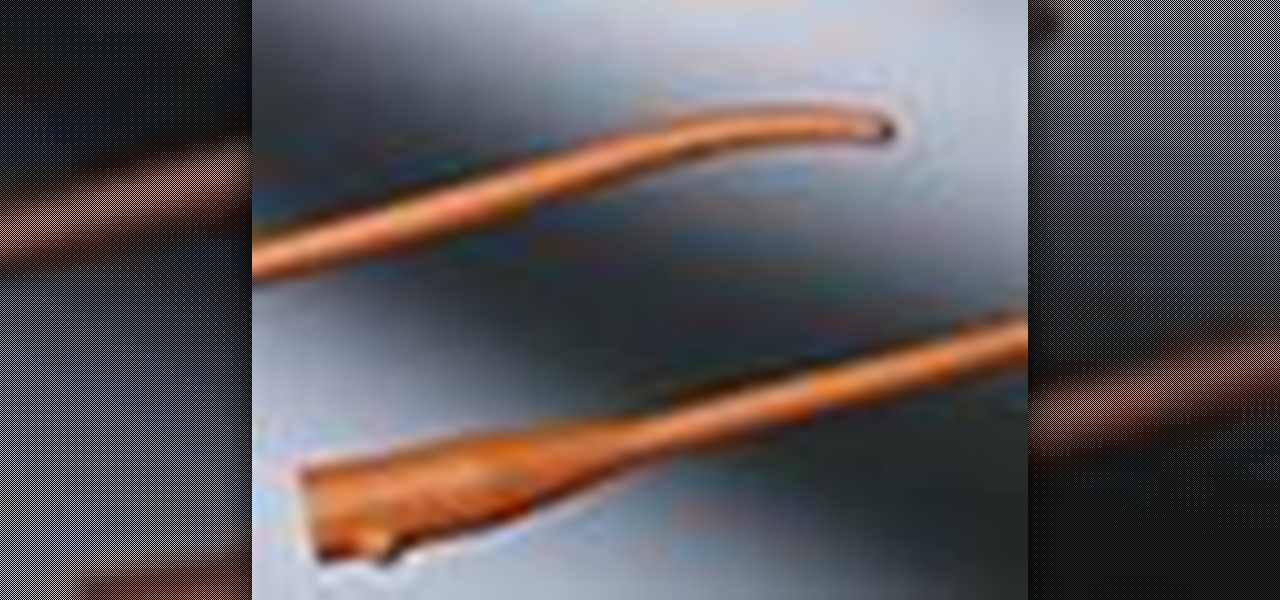
How To: Insert a urinary catheter into a male patient
Catheterization is used to drain a patient's urine freely from the bladder or to inject liquids for treatment and diagnosis of certain bladder conditions. Cathing is usually done at a clinic by a nurse, although self-catheterization is also possible.

How To: Detect the symptoms of Parkinson's Disease
Fear someone you love might be showing signs of Parkinson's disease? Parkinson's disease is a chronic condition caused by a lack of dopamine in the brain. Diagnosis can sometimes take years; knowing symptoms can speed up the process.

How To: Avoid getting mononucleosis
Mononucleosis, an infection caused by the Epstein-Barr virus, can strike anyone, but those who experience the worst symptoms are teenagers. Follow these simple steps to avoid getting this virus.

How To: Recognize signs of a bladder infection
Stop a bladder or urinary tract infection in its tracks by learning what to look for and how to prevent it from getting worse.






